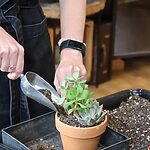The arrival of a new plant is always a cause for celebration and lots of excitement, whether you await a parcel from an online order, constantly refreshing tracking details, or run home from the plant shop to introduce your new gem to your beautiful indoor jungle.
As both plant sellers and devoted plant enthusiasts for years, we’ve walked in your shoes. However, what should you do when your new plant is not thriving as expected? In this article, we will explore the most common reasons behind the challenges faced by new plant owners.
Unsuitable Environment

One of the common causes of plant struggles is choosing a species that doesn’t match your home environment. Picture this: you’ve dreamed of a massive euphorbia succulent, yet you intend to keep it in a semi-shaded corridor or display a Calathea White Fusion on a sunny windowsill, right above a scorching radiator.
Another example which we experience often is people wanting plants for their windowless bathrooms and not providing artificial full-spectrum light. While we do understand the vision of having a massive monster right next to the shower which will give jungle vibes during home SPA, plants will not appreciate it.
Our visions and plans do not always match houseplants’ needs and plants should always be selected based on the specific conditions in the location where you plan to place them.
This is why you must ensure that your new plant receives the appropriate lighting, humidity, and temperature levels required for its optimal growth.
We are always happy to help with this, and you can make use of Mossbot, our care guides and our articles to help you make the right decision for you and your plant.
Transport Stress

In their natural habitat, plants don’t experience long-distance travel or even any travel! They grow in the same locations their whole life and the conditions are generally quite consistent
Once we pack them into boxes or bags and move them, even over short distances, it can be a highly stressful experience for them. You may observe symptoms such as yellowing or drooping leaves for example. Fortunately, this drama usually subsides in a few days as the plant adjusts to its new surroundings.
However, to minimise plant stress, it is crucial to choose delivery options that prioritise speed and warmth, especially during the winter months. We always recommend adding a heat pack during cold months to keep plants cosy and we always choose the fastest delivery method.
It is also important to keep an eye on tracking details and make sure you’re available for delivery to prevent your plant from spending unnecessary time in dark, chilly boxes in courier company warehouses.
If you are not at home, update your tracking and get the plant delivered to your neighbour or collection point. Never ask the courier company to leave the box outside your home, during low winter and hot summer temperatures this can negatively impact your plant, making travelling and adapting to the new home process more difficult.
It is also an industry standard that plant sellers have disclaimers which state that they will not take responsibility if the plant is damaged because you chose to leave the plant outside, so it is best to ensure your plant is kept safe and sound throughout its journey home.
One-Size-Fits-All Plant Care
Sticking to a very strict watering schedule, regardless of the season or plant variety, can lead to problems with new plants. Because this way of care was fine with your other plants doesn’t mean that your new plants will be happy with this arrangement.
Each plant has different watering, sunlight and humidity requirements. Some may thrive with infrequent watering, while others demand consistently moist soil. Before welcoming a new plant into your indoor jungle, check our care guides to ensure proper care and prevent potential issues.
While in our Aberdeen shop it is easier to check if customers knows everything they need about their new plants, online customers might feel somewhat isolated. This is why we publish plants care guides on our website and provide the MossBot tool for instant advice. Mossbot will answer all your questions about all our plants, their care and more. We listen to your feedback and regularly post articles and blogs answering the most common questions and topics which our customers find interesting. Understanding plants needs plays a critical role in plant care, so always take the time to peruse plant care guides. A 5 minute read can save you a lot of time further down the road.
Impatience
Have you ever brought home a new plant and, on the very same day, rushed to repot it into fresh soil and a bigger pot, take cuttings, add plant food, and meticulously clean its leaves with neem oil for that extra shine? Most new and experienced plant parents are guilty of this enthusiasm at some point.
While it might seem harmless in certain cases, it can damage the plant, causing undue stress to our precious new member of the family.
We always recommend our customers exercise some patience and give their new plants a little time, at least 1-2 weeks. Even if the pot looks a bit small, the soil appears in need of changing, or one of the leaves has unsightly brown edges you’re tempted to trim, it’s best to hold off. Changing the plant’s environment, as described earlier, can be highly stressful, and there’s no need to add extra pressure.
When you bring home a new plant, it’s hard to know when it was last fertilised, so adding even basic plant food can risk overdosing it with nutrients and cause more drama. Instead, let the plant get used to its new home. During this waiting period, you can research your plant’s specific needs, ensure you’re using the right soil, and learn the best way to propagate it.
We’ve rarely seen plants die from being left in a slightly too-small pot for a few extra weeks. However, we’ve seen many plants struggle or even die within a very short period of time from the stress of too much attention and care too quickly.
There are some specific examples when you should not wait and treat the plant immediately like pest issues or overwatering but in 99% of occassions it is better to be patient and give your plant the time it needs to settle in and thrive. By doing so, you’ll spare your new green family member unnecessary suffering and ensure a healthier and more successful plant-parenting experience.
Remember, if in doubt we are always here for you and delighted to help you out.
Conclusion
These are the most common mistakes that new plant owners encounter, based on our extensive experience with customers. While the excitement of getting a new plant is undeniable, it’s important to invest time and effort into researching and providing the appropriate care for your new plants. This article serves as a friendly reminder to all plant enthusiasts, new and experienced, offering invaluable guidance to ensure that your new additions to inoor jungle will thrive since day one.

















